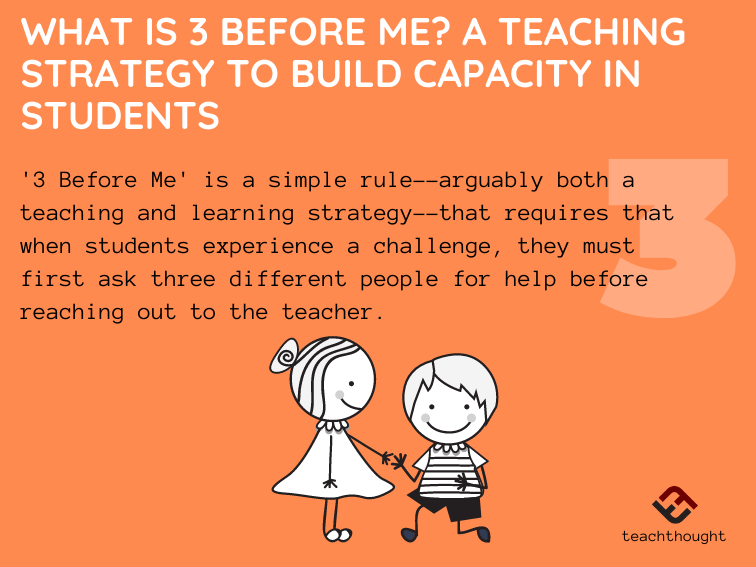

by TeachThought Staff
What is’ 3 Before Me’?
3 Prior to Me’ is an easy classroom method– perhaps both a mentor and learning strategy– that calls for that when students experience an obstacle, they should first ask three various individuals for help before connecting to the educator.
A development of that approach? When trainees become ‘stuck,’ they need to initially attempt to address the problem in three various methods before asking the teacher. This makes it extra versatile. You can require pupils to ask someone and look for two sources or two people and one source. You likewise can group students in your classroom and require students most likely to a single person from 3 of the teams. (You can group by basic capability, material location, social elements, and so on)
Trainees’ ability to solve troubles both independently and collaboratively is an essential element of a modern-day, reliable classroom. When pupils get ‘stuck’ or aren’t certain where to go or what to do next, the educator is usually the first place to go. Yet in a class– whether digitally attached or otherwise– they usually can solve the concern by themselves or obtain aid from multiple sources. To really encourage pupils in this age of information requires that we develop in students the ability, desire, ability, and propensity to browse intricate tasks and info.
And this ‘regulation’ is a basic way to begin.
What Does’ 3 Before Me’ Require?
Certainly, this strategy calls for that students develop a growth attitude (i.e., that they believe that they can) and technique with time to construct it as a discovering response. It also needs there to be real ‘solutions’ in the class: more well-informed pupils, books, an online search engine, encyclopedias, etc. The ‘stuck’ doesn’t need to be scholastic, certainly. If it’s a matter of classroom procedure, procedure, or instructions,’ 3 Prior to Me’ is more immediate and reliable. If the issue is based upon abilities or material knowledge, the probability of the educator requiring to obtain included is still higher yet is still less than 100 % (as it is before utilizing a technique like this).
With time this technique can be a good beginning point for converting students from ‘find out to do’ to ‘learn to do well.’ Obviously, there may still remain ‘areas for development,’ which is why the alternative ‘learning + others + caring’ approach that accompanies’ 3 Before Me!’ is important. Past mastery of content knowledge and the capability to believe critically, trainees also require time (both experientially and temporally) to expand in other areas and develop capability as visitors, writers, and thinkers– that is, as ‘pupils.’ We discover more in connection with and alongside our peers instead of being compared to them.
Just via development and independence from institutions and adults can we produce a society that can in fact impact adjustment– grow and solve persisting obstacles. To progress rather than reproduce itself. Dynamic training and finding out models need to be ‘people first’ and concentrate on aiding people create their capabilities to recognize address problems on their own. Certainly,’ 3 Before Me’ isn’t a world-changing tactic. It’s simply an action toward trainee self-directed knowing developed around a self-organized knowing environment.
Conclusion
In institutions, trainees typically discover in regard to books and adults as opposed to in regard to nature, objects, or other environments. As opposed to describing learning in terms of levels of understanding, deepness, or intricacy, we recognize success as relative and evaluate finding out with subjective examinations of just how well students did about specific learning purposes as opposed to how well they identified problems, looked for resources, persisted through uncertainty and, in time, constructed finding out proficiency (i.e.g, discovering just how to discover)
While’ 3 Prior to Me’ isn’t constantly ‘solving complex troubles’ concerning ‘understanding,’ the consistent use it gradually can assist students achieve understanding in manner ins which produce an even more lasting understanding atmosphere for both educators and students.
What Is 3 Before Me? A Teaching Technique To Develop Ability In Pupils